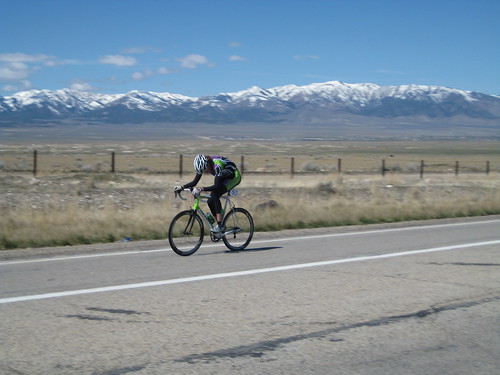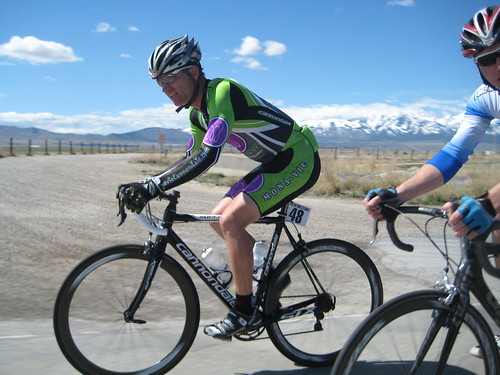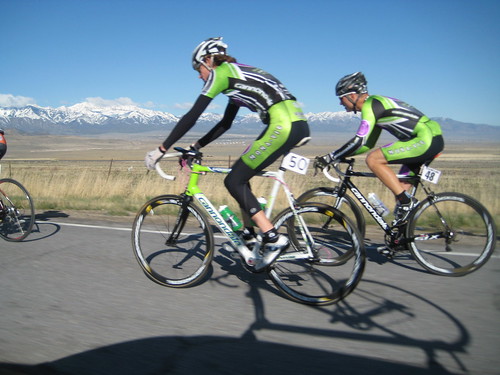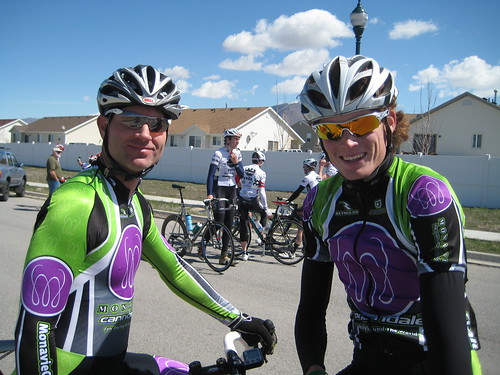Thursday, April 30, 2009
Armstrong races & BMC out!
Wednesday, April 29, 2009
Design Differences! Not all motors are the same!
Apr 27 |
1st Carey Lowery Outdoor Store - 55nine Performance
2nd Paula Burk
3rd Daniel Musto
4th Betsy Shogren
5th Emily Brock - Faster Mustache - 55nine Performance
I know there was a few WN users on the men's podium as well......Jeremiah Bishop 2nd & Sam Korber was top 10. Waiting for results there. I had a flat within the first 5 minutes and entered the woods in 110th place! Talk about bad starts.
Eddie O'Dea
55nine Performance
http://55nineperformance.com
Articular hyaline cartilage You can find basic info on cycling, but here is one you might not understand. No two people have the same cartilage in the knee, it is not uniform and varies from younger to older! |
Think about where the forces are a
nd this will start to make sense why we measure you the way we do it. The focus today is on the knee.

The articular surface of the distal femur, the articular surface on the posterior aspect of the patella and the articular surfaces on the tibial plateau are covered by a variety of hyaline cartilage termed articular hyaline cartilage. In a healthy person, articular hyaline cartilage offers a firm, smooth and relatively friction-free surface facilitating joint movements. The thickness of articular hyaline cartilage in the knee is not uniform and varies from 3 mm to 7mm. Articular hyaline cartilage possesses a degree of compressibility and elasticity. These features enable the articular surfaces to dissipate laterally the vertical compressive forces to which the knee joint is subjected during weight transmission and deep compression of the knee, semi weight bearing as sitting on a saddle.

Articular hyaline cartilage does not usually ossify.
The surface of articular hyaline cartilage is lubricated by synovial fluid secreted by the synovial membrane lining the inner surface of the joint capsule. However, the articular cartilage itself is not covered by synovial membrane. As with hyaline cartilage in extraarticular sites, the substance of articular hyaline cartilage is made up of cells termed chondroblasts and chondrocytes, and an intercellular matrix elaborated by the chondrocytes. The intercellular matrix is biochemically complex, and is composed of various proteins including different types of collagen, a variety of cell adhesion molecules and glycosaminoglycans, and lipids. The glycosaminoglycans are arranged systematically about a core protein to form complex hydrophilic molecules termed proteoglycans. The proteoglycans are chiefly responsible for the impressive viscoelastic biomechanical properties of articular cartilage.
Healthy articular hyaline cartilage in the young individual has a pale and glistening appearance, and a firm and smooth texture. With age and weight degenerative changes begin to appear, and cartilage loses its smooth and glistening character. Think sand-paper!
At the histological level, articular hyaline cartilage is seen to be made up of four layers or zones on the basis of differences in cellular morphology, cellular density as well as differences in the composition of extracellular matrix.
Of the four layers, the most superficial layer faces the joint cavity, and the deepest layer is apposed to, and fused with, the subchondral bone.
From superficial to deep, these layers are named as follows:
i) Tangential stratum (Zone 1).
ii) Transitional stratum (Zone 2).
iii) Radiate stratum (Zone 3).
iv) Calcified stratum (Zone 4).
The region between Zone 3 and Zone 4 is called the tidemark and is readily discernible in young cartilage. The progressive ossification of Zone 4, which accompanies aging, results in the blurring of the tidemark. That means the compression rates are very different for a younger person vs. an aging person.
Articular hyaline cartilage is devoid of innervation and lymphatic vessels. Except for the presence of a few blood vessels in Zone 4, articular hyaline cartilage is also normally devoid of vascularity, and is believed to derive its nutrition mainly by diffusion from synovial fluid and from the vascular plexus in synovial membrane.
Sunday, April 26, 2009
30th Athens Twilight Crit Results. DESIGN DRIVEN!

Behind every great race car is a computer-aided design (CAD) engineering, and manufacturing team.
A motor is a motor right? Wrong! There are many types of motors and they are designed for different needs. They rate their power by using the term "horsepower" just like we do on a bike. More horses, more go power!
Its that arbitrary unit of measure that has made its way through the centuries and now appears mostly to cars, but also to your bike or lawn mower! We must point out that we have seen a few people make more than 2.5 horsepower and that was for only 6 seconds and he was a world champ in track and it is said that he hit almost 60mph.

- It's super lightweight.
- It's super strong.
- It's super stiff.
- It can be easily molded into all kinds of different shapes.

- Displacement is large (Mark Hekman) - Not many cars have engines this big, but the ones that do usually generate well over 300 horsepower.
- NASCAR engines have extremely radical cam profiles, in which open the intake valves much earlier (getting on the stroke early) and keep them open longer than street cars. This allows more air to be packed into the cylinders, especially at high speeds!
- Intake & exhaust are tuned and tested to provide a boost at certain engine speeds. They are also designed to have very low restriction, and there are no mufflers or catalytic converters to slow the exhaust down either (sit up affect the intake & exhaust of breathing).
- They have carburetors that can let in huge volumes of air & fuel - no fuel injectors on these engines. Sounds like V02 Max?
- They have high intensity programmable ignition systems so the spark timing can be custominzed to the provide the most possible power! Don't expect a motor that gets good gas mileage to win races!
- Then you have all the sub-systems like coolant pumps, steering pumps & alternators designed to run at sustained high speeds & temperatures.
30th Athens Twilight Criterium
USA, April 25, 2009
Results
Men 1 Heath Blackgrove (Hotel San Jose) 2 Mark Hekman (Mountain Khakis) 3 Adrian Hegyvary (Hagens-Berman) Women 1 Brooke Miller (Team TIBCO) 2 Tina Pic (Colavita-Sutter Home) 3 Jen McRae (Team Type 1)
Past winners
2008 Rahsaan Bahati (Rock Racing)
2007 Mark Hekman (Abercrombie & Fitch) 2006 Vasili Davidenko (Navigators) 2005 Vasili Davidenko (Navigators) 2004 Brice Jones (Health Net)
2003 Dan Schmatz (7UP-Maxxis)
2002 Gord Fraser (Mercury) Monday, April 20, 2009
Georgia Gould solos to XC win at Sea Otter.
Two wins in two days in Monterey, CA for WN & Myo-facts sEMG/Dartfish users!
Gould solos to win in the heat!
This is an area of extreme weather. It can be cold/wet or 6 inch mud, but this year they even shortened the race due to the extreme heat. Georgia has a history dealing with heat, she is more of a snow bird and her motor runs hot (lots of horsepower) and works very well in the cold, but not this time, she flew away for the win! She was off the front in clean air and never looked back!
Sea Otter is a race where Georgia first started to make a name for herself on the Luna team. She has a few tricks about the straights and learned to haul it on that kind of course. Wobble-naught fast!
Georgia Gould (Luna) hit the gas early and launched an attack early on the very first lap. She has learned a few things from the elite level cyclocross. You race from the gun. As normal, long time teammate Katerina Nash (Luna) went with her to set the fast pace.
"I was first into the first downhill and Katerina was right on my wheel and said, 'We've got a gap," but then I blew a corner and she went by. That was great since she's an awesome downhiller. She let me by on the first singletrack and I was able to get a gap."
Within the next 15 minutes, Nash was caught by the chasers including Catharine Pendrel (Luna), Lene Byberg (Specialized), Kelli Emmett (Giant) and Emily Batty (Trek) until Pendrel and Lene Byberg (Specialized) escaped the others. The pair battled each other until nearly the finish.
Pendrel was under no obligation to chase her teammate Gould down. As she pointed out, Georgia in the beginning was really strong today."
All the racers appeared to suffer some in the heat. "It was really hot. My hands were hot and the skin on my legs was hot," said winner Gould.
Gould likes a long race. "Orginally I thought that I was not that happy about the race being shortened because that's what Sea Otter is about. It's long and it's one of the few races where we get to do the same distance as the pro men. As it turns out, it was good for me. I ended up on the dehydrated side a little. When it's this hot, it's hard to drink enough."
Georgia Gould knew her chasers were never too far behind but kept looking forward (kept the focus on each stroke) - toward catching more guys (the men started 15 minutes ahead of the women) - rather than looking back.
Elite women
1 Georgia Gould (Luna) 1.22.45 WN & Myo-facts sEMG/Dartfish
2 Lene Byberg (Nor) Specialized 1.07
3 Catharine Pendrel (Luna) 1.14
4 Kelli Emmett (USA) 3.58
5 Willow Koerber (USA) Subaru Gary Fisher 4.09
6 Pua Sawicki (USA) 4.15 WN & Myo-facts sEMG/Dartfish
7 Katerina Nash (Luna) 5.22
8 Heather Irmiger Subaru Gary Fisher 6.17
9 Jenna Rinehart Specialized 7.02
10 Lorenza Morfin 7.37
11 Emily Batty (Can) Trek Store 8.08 WN & Myo-facts sEMG/Dartfish
Sunday, April 19, 2009
Emily Batty (Trek) Sea Otter short track. Her Career-Best@
Trek’s young Emily Batty wins women’s short track, she is coming of age!
Emily is not new to us and we have watched her progress to the elite level using our CAD she has been. on Wobble-naught for years! She started using the fit under Steve Neal a WN dealer a few years ago.
Batty jumped with half a lap to go on a paved climb, and held her lead to the finish.
“I just felt like I had so much energy,” Batty said. “It will be a good opener for (the cross-country race) tomorrow.”
As with Pendrel and her teammate Georgia Gould, who finished fourth, Byberg had just traveled from the World Cup in South Africa the prior weekend. Next weekend she’s racing in Germany.
About midway through the race Byberg drilled it at the front of a group. For a time she was alone off the front with Gould. Then a lead group of five formed: Byberg, Gould, Pendrel, Irmiger and Batty.
Race winner Batty expected the short track to be a good opener for her legs ahead of Sunday’s cross-country event.
We where on the phone with her about her arm placements and it seems to have made a difference!
Results
Elite men
1 Todd Wells
2 Burry Stander
3 Carl Decker
4 Jeremiah Bishop WN & Myo-facts sEMG/Dartfish
5 Sam Schultz
Elite women
1 Emily Batty WN & Myo-facts sEMG/Dartfish
2 Lene Byberg
3 Catharine Pendrel
4 Heather Irmiger
5 Georgia Gould WN & Myo-facts/Dartfish
Thursday, April 16, 2009
Jeff Louder (BMC) Good Form! Makes Scheldeprijs Break!
Louder had to work very hard to make the move of the day. He said he attacked several times in the beginning part of the race until the move of the day formed at about kilometre 53.
We have seen a lot of success from the WN & Myo-facts sEMG/Dartfish solution in the longer harder races e.g. 24 hours, race across something? It makes sense, if your fit is correct, you have a better chance at the longer harder events! That's a good test to say that one way works better than another!
"There aren't a lot of chances to go out and do 200 kilometres in the US at that kind of speed. I was fading in the end.
You always hear it and wonder how different is it across the pond? "I thought if we get caught at 20 kilometres to go then I can keep working. But later I thought, 'Wow, this [break] could actually make it.'"
When Louder realised there was a chance to stay away, he opted to saved his energy. "I felt really bad for the other three, but I had to sit on just because I was [taxed]. Fourth place is better than getting dropped and having those three win."
In most world level races its best to understand that the race is determined by the peloton bringing their sprinter's up at the end to drag race. Its part of the game plan for each team. People going off the front is not the norm!
Under the control of Quick Step and Saxo Bank the peloton caught Louder and Matthé Pronk (Vacansoleil) at kilometre 191. Lorenzo Bernucci (LPR Brakes-Farnese Vini) and Pavel Brutt (Katusha) battled on for another five kilometres.
One day Jeff is going to pull his breaks off. Louder on sizing up the race. "That's definitely a bigger deal than Redlands - no live TV at Redlands!" Just think if we had the fan base here?
Allessandro Petacchi took his 1st win in Belgium by out-sprinting the competition.
He was also able to stay clear of the huge crash, in which took out many of the key sprinters. Petacchi's team was reduced due to his teammate Lorenzo Bernucci being in the break with Louder, again was caught (ONLY) a few kilometers from the finish! Sounds like the Amgen Tour of CA?
Jeff has been working with Craig Upton who provides our services in CA.
Tuesday, April 14, 2009
Super6 Weekend for Team Monavie-Cannondale
Supersix Weekend
April 13th, 2009 | Posted by PhD PT Bart Gillespie | Topic: racingWithout any mountain bike races scheduled over Easter Weekend, Team Monavie-Cannondale saddled up the Supersix’s and got after some road races in various Regions across the country.

West Virginia/Pennsylvania:
Jeremiah Bishop found a way to make a hard road race even harder. Chase solo for 12 miles, hit a dog head on (this is normal in West Virgina), catch the 2 man break, and then attack it 2 miles out for the win. There’s got to be an easier way!
Durango, Colorado:
As reigning Collegiate National Mountain Bike Champion, Ben Sontagg is a marked man at any collegiate race. Upon return from South Africa andthe grueling Cape Epic, Ben foundthe Fort Lewis College home road race a perfect opportunity to wind up the legs in preparation for the big show at Sea Otter. In the snowy Criterium Ben was watched closely, nipped at the line., and had to settle for 2nd. The following day was a more selective course where Ben was able to use his raw power and drag race up a 10% grade to the finish with enough time to celebrate the win . Looks like he’s ready for the Otter!

Tooele, Utah:
Mitchel Petersen, who is known as a road hill climb specialist decided to line up for the pan flat Tour of the Depot Stage Race in Tooele, Utah. In his support was Team Director Matt Ohran,who after a 3 year hiatus from road racing nearly stole the show on the final stage. Matt worked himself into a 2 man break with Kai Applequist (Team Bobs-Bicycles.com), a new pro from Boise, ID for 35 miles from the finish and hung on to the end, once again leading by example. That's right, WN & Myo-facts sEMG/Dartfish does the fits for both teams! Mitchel then blew the field apart in the final miles to finish 3rd.
If you wish to stay in the game, you best not wear out! You might say that Dr. Gillespie knows more "truth" about what we do, he has been using WN & Myo-facts sEMG/Dartfish for a number of years, staying at the top of his game, the whole time as a professional in PT. He knows what we he has learned from the sEMG /Dartfish and how important it is to do it "free from error" and will not depart to other fitting or conforming social opinions! Bart is now a Dr. of PT and also an instructor at the University of Utah in the Division of Physical Therapy. Bart has used & worked with us since the days when his teammate, multi Dr. Exercise/Phys Sally Warner (Team Biogen) took the 2002 World MTB Masters using WN CAD/sEMG! Sally being a person of science saw first hand how (using her brain) to fire her own muscles, not what someone else thinks is key! That made the difference!



Not bad for a Mountain Bike Team!
www.Monvie-Cannodale.com
Tuesday, April 07, 2009
Pua Sawicki "Getting The Sea Legs" Wins US Cup #3



